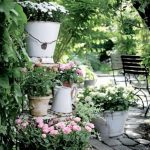Are you looking for garden design ideas for long narrow gardens? Long, narrow outdoor spaces present unique challenges and opportunities when it comes to landscaping and design.
In this article, we will explore creative solutions to make the most of your long narrow garden, from maximizing vertical space to selecting the right plants and incorporating focal points. Whether you have a courtyard, alleyway, or unusually shaped backyard, these ideas will help you transform your space into a beautiful and functional outdoor oasis.
Long narrow gardens can be tricky to work with, but they also offer the chance to create a truly unique and impactful outdoor area. Understanding the specific challenges that come with these types of spaces is crucial in order to make the most out of them.
From making use of vertical structures such as trellises and pergolas to utilizing mirrors for enhancing the perception of space and light, there are many ways to turn a long narrow garden into a stunning and inviting environment.
In the following sections, we will delve into various aspects of designing for long narrow gardens, including creating visual interest with pathways and borders, selecting the right plants, incorporating focal points like fountains or sculptures, practical considerations such as maintenance tips and irrigation solutions, as well as lighting for ambiance and functionality. By understanding these challenges and opportunities, you can effectively plan and execute a beautiful garden design that maximizes the potential of your long narrow outdoor space.
Making the Most of Vertical Space
Long narrow gardens present a unique set of challenges when it comes to garden design ideas. However, with some creativity and strategic planning, these spaces can be transformed into stunning and functional outdoor retreats. One effective way to maximize the use of space in a long narrow garden is by making the most of vertical space. By utilizing trellises, pergolas, and vertical planters, you can create a lush and visually captivating environment.
Trellices as Statement Pieces
Trellises are not only practical for supporting climbing plants but also serve as beautiful focal points in a long narrow garden. Choose trellises with interesting designs or incorporate custom-made ones to add personality and charm to your outdoor space.
Pergolas for Shade and Structure
Pergolas provide both shade and architectural interest in long narrow gardens. By adding a pergola, you can create a defined outdoor living area while also visually breaking up the length of the garden. Consider adorning your pergola with climbing plants or string lights for added ambiance.
Vertical Planters for Greenery
Vertical planters are an excellent solution for adding greenery without encroaching on valuable floor space. From wall-mounted containers to hanging baskets, there are numerous options available to bring life and color to the vertical elements of your garden design ideas for long narrow gardens.
Creating Visual Interest With Pathways and Borders
Long, narrow gardens present a unique set of challenges and opportunities when it comes to landscaping. One of the key aspects to consider is how to create visual interest within the limited space available. Utilizing pathways and borders effectively can make a significant difference in adding depth and dimension to the garden.
Curving Pathways
One effective way to break up the length of a long narrow garden is by incorporating curving pathways. Curved paths not only add visual interest, but they also create the illusion of a larger space by obscuring what lies beyond the curve. This technique can help to create a sense of mystery and discovery as visitors navigate through the garden.
Patterned Plantings
Another way to add visual interest is by incorporating patterns within the plantings along borders or pathways. Using plants with different textures, colors, and heights can create a striking visual effect that draws the eye and adds complexity to the garden. Consider using alternating rows of tall grasses and low-growing flowers or shrubs to create a sense of rhythm and movement.
Textured Hardscaping
In addition to plants, incorporating textured hardscaping materials such as gravel, pavers, or mosaic tiles can also add depth and dimension to a long narrow garden. Different textures underfoot can create variation in the landscape, making it more visually interesting as well as functional for walking paths or seating areas.
By thoughtfully designing pathways and borders with curves, patterns, and textures, it is possible to transform a long narrow garden into a dynamic and visually engaging space that feels much larger than its actual dimensions.
Selecting the Right Plants
When it comes to garden design ideas for long narrow gardens, one of the most important considerations is selecting the right plants. Choosing narrow, upright, and columnar plants can help maximize space and create a sense of height and depth in a confined area. These types of plants not only add visual interest but also play a functional role in optimizing the layout of a long narrow garden.
One popular choice for long narrow gardens is to incorporate tall, slender trees such as Italian cypress or juniper. These evergreen trees not only add vertical interest but also provide privacy and screening along the borders of the garden. Additionally, they can help create a sense of enclosure without taking up too much horizontal space.
In addition to trees, narrow and upright shrubs such as tall grasses, bamboo, or yucca can be strategically planted to define pathways or borders within the garden. By choosing plants with a vertical growth habit, it is possible to create distinct areas within a long narrow garden while maintaining an open and spacious feel.
Lastly, climbers and vining plants can be trained to grow on trellises or pergolas, adding height and greenery without encroaching on valuable ground space. This technique not only allows for more planting options but also adds texture and visual appeal to vertical surfaces in the garden.
| Plants | Benefits |
|---|---|
| Italian Cypress | Privacy, screening, vertical interest |
| Tall Grasses | Define pathways and borders, open feel |
| Climbers/Vining Plants | Adding height without taking up ground space |
Incorporating Focal Points
When designing a long narrow garden, it’s essential to incorporate focal points to break up the length and create visual interest. Features such as fountains, sculptures, and seating areas not only add beauty but also serve as functional elements that can enhance the overall ambiance of the garden. These focal points can also serve as landmarks that help divide the space into distinct areas, making the garden feel more dynamic and inviting.
One effective way to add focal points in a long narrow garden is by installing a water feature such as a fountain or a small pond. The sound of flowing water can create a soothing atmosphere and mask any surrounding noise, while the sight of shimmering water adds an element of tranquility and beauty. Additionally, water features can also attract wildlife such as birds and butterflies, breathing life into the garden.
Another way to incorporate focal points is by strategically placing sculptures or art installations throughout the garden. Sculptures can serve as eye-catching elements that draw attention and create a sense of intrigue. They can also act as visual anchors that provide structure and balance to the garden design. Seating areas, on the other hand, offer practical functionality while serving as focal points that encourage people to pause, relax, and enjoy the surroundings.
In addition to fountains, sculptures, and seating areas, other options for adding focal points in long narrow gardens include arbors, pergolas, decorative screens, or even vertical planters with cascading flowers or vines. These features not only contribute to breaking up the length of the garden but also allow for creative expression and personalization of outdoor spaces.
| Garden Design Ideas | Features |
|---|---|
| Fountains | Adds beauty and creates soothing atmosphere |
| Sculptures | Create visual interest and act as visual anchors |
| Seating Areas | Offer practical functionality while serving as encouraging rest stops |
Utilizing Mirrors and Reflective Surfaces
Long narrow gardens can often feel cramped and closed-in, but there are several garden design ideas for long narrow gardens that can create the illusion of space. One effective way to enhance the perception of space and light in a long narrow garden is by utilizing mirrors and reflective surfaces. Mirrors have the ability to make a space appear larger than it really is, while also bouncing natural light around the garden.
Here are some ways to incorporate mirrors and reflective surfaces into your long narrow garden:
- Install a large mirror on a wall or fence at the end of the garden to create the illusion of an extended space.
- Use mirrored mosaic tiles as an accent on pathways or as part of a feature wall to add depth and interest.
- Position reflective surfaces strategically throughout the garden to capture and reflect sunlight, brightening up darker areas.
In addition to using mirrors, consider incorporating other reflective materials such as stainless steel sculptures, glass ornaments, or metallic planters. These elements will not only enhance the perception of space and light in your long narrow garden but also add visual interest and flair. By implementing these design ideas, you can transform your long narrow garden into a visually stunning and inviting outdoor space.
Lighting for Ambiance and Functionality
When it comes to garden design ideas for long narrow gardens, lighting plays a crucial role in creating ambiance and functionality. Proper lighting not only highlights key areas but also contributes to the overall atmosphere of the garden. Here are some tips for using lighting effectively in long narrow gardens:
- Pathway Lighting: Installing pathway lights along the length of the garden not only helps to guide visitors but also adds a warm and inviting glow. Opt for low-level, subtle lighting to avoid overpowering the space.
- Accent Lighting: Use spotlights to highlight focal points such as sculptures, water features, or architectural elements. This not only adds visual interest but also breaks up the length of the garden by drawing attention to specific areas.
- Ambient Lighting: Consider string lights or lanterns to create an inviting and cozy atmosphere, especially in seating areas or gathering spaces. Soft, diffused lighting can help to soften the lines of a long narrow garden and create a more intimate setting.
In addition to creating ambiance, it’s important to consider functionality when it comes to lighting in a long narrow garden. Make sure that key areas such as entryways, seating areas, and outdoor dining spaces are well-lit for safety and convenience. By carefully considering both ambiance and functionality, you can make the most of lighting in a long narrow garden design.
Practical Considerations
In conclusion, designing a garden for a long narrow space comes with its own set of challenges, but with the right approach, it can also offer unique opportunities for creativity and innovation. By utilizing vertical space with trellises, pergolas, and vertical planters, homeowners can maximize planting area without sacrificing valuable floor space. Additionally, incorporating pathways and borders with curves, patterns, and textures can add visual interest while creating the illusion of depth in a confined area.
Selecting the right plants is crucial in a long narrow garden, as choosing narrow, upright, and columnar plants can help to maximize space and create a sense of height. By carefully considering focal points such as fountains, sculptures, and seating areas along with the strategic use of mirrors and reflective surfaces, homeowners can break up the length of the garden and enhance the perception of space and light.
Furthermore, proper lighting not only adds ambiance to the garden but also serves a functional purpose in highlighting key areas.
Practical considerations like maintenance tips, irrigation solutions, and maximizing functionality must not be overlooked when designing a long narrow garden. With these elements in mind, homeowners can ensure that their garden remains not only visually appealing but also sustainable and easy to maintain for years to come.
In essence, there are numerous creative possibilities when it comes to garden design ideas for long narrow gardens; by addressing both aesthetic and practical considerations simultaneously, homeowners can make the most of their limited outdoor space.
Frequently Asked Questions
How Do You Landscape a Long Narrow Area?
Landscaping a long narrow area requires careful planning to create visual interest and prevent it from feeling cramped. Consider using different levels, creating winding pathways, and incorporating vertical elements like trellises or tall plants to add depth.
How Do You Break Up a Long Narrow Garden?
Breaking up a long narrow garden can be achieved by dividing it into smaller “rooms” with distinct purposes or themes. Utilizing hedges, fences, or even strategically placed trees can help create separate areas within the space.
How Do You Plant a Narrow Garden?
Planting a narrow garden involves selecting plants that will thrive in the specific conditions of the area, such as sunlight exposure and soil type. Utilize vertical gardening techniques like trellises or hanging baskets to maximize space and add variety to the garden’s appearance.

Welcome to my gardening blog! I am passionate about plants and enjoy sharing my knowledge and experiences with others. In this blog, I will write about everything related to gardening, from tips on how to get started to updates on my own garden projects.





